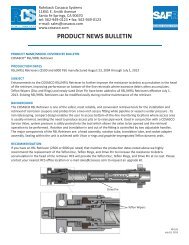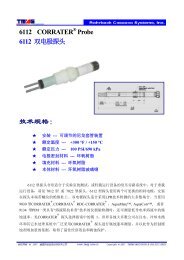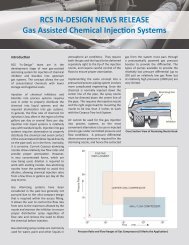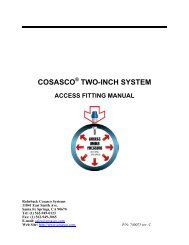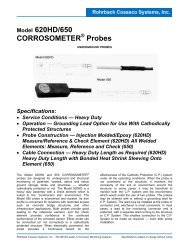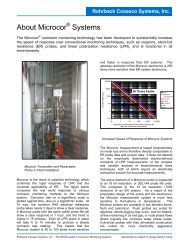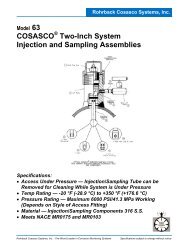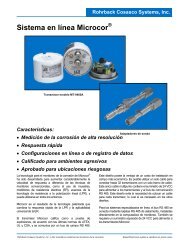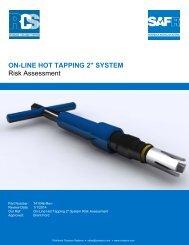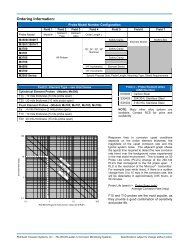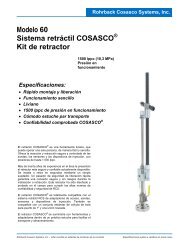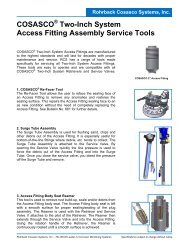COUPON HOLDER ASSEMBLIES - Rohrback Cosasco Systems
COUPON HOLDER ASSEMBLIES - Rohrback Cosasco Systems
COUPON HOLDER ASSEMBLIES - Rohrback Cosasco Systems
- No tags were found...
Create successful ePaper yourself
Turn your PDF publications into a flip-book with our unique Google optimized e-Paper software.
COSASCO TWO-INCH SYSTEMINSTALLATION, OPERATION & MAINTENANCEMANUALCORROSION <strong>COUPON</strong>S (Alloy Specimens) &<strong>COUPON</strong> <strong>HOLDER</strong> <strong>ASSEMBLIES</strong><strong>Rohrback</strong> <strong>Cosasco</strong> <strong>Systems</strong>11841 East Smith Ave.Santa Fe Springs, CA 90670Tel: (1) 562-949-0123Fax: (1) 562-949-3065E-mail: rcs@rohrbackcosasco.comWeb Site: http://www.rohrbackcosasco.com P/N 740075 Rev. -
1Chapter 1IntroductionCorrosion coupons are one of the longest used methods for the study of corrosion and its effects.They are relatively small, easily inserted and retrieved, and are an economical means ofdetermining cause and effect of corrosion.As with any type of corrosion detection device, coupons may not give absolute definitiveanswers, but will indicate general corrosion behavior patterns. They may be used in conjunctionwith other means of corrosion monitoring devices developed for specific and peculiar types ofcorrosion (for example; galvanic, pH, thermal, etc.).For best results, the interpretation of the results should take into consideration the location andorientation of exposure, the composition of product media and other variables.
2Chapter 2GeneralIt is important to remember that coupons indicate the attack of the environment only at the pointof exposure. Therefore, coupons should be installed as closely as possible to the point wheresurveys are desired. That is, near pipe wall surfaces, vessel surfaces, tube sheets, trays, up-streamof major tie-ins; and in areas of turbulence, changes in velocity and temperature. The single orcombined effect of the product environment temperature, solution concentration, agitation,aeration, pH, velocity and bacteriological attack will also affect the coupons. To the degree thateach of these can be considered in relation to each other and entered into the interpretation of theresults, the more beneficial the coupon corrosion rate data will be.
3Chapter 3Types of Corrosion Coupons(Refer to Figure 1):Coupon material may be as varied as line or containing vessel material. The most widely usedmaterial is mild or low carbon steel, such as AISI-1018.Additionally, coupon configuration may be quite varied depending upon their application.Ideally, the ratio of area to material density and total area to edge area should be large. Severaltypes of coupons and a brief description of each follow:Strip Coupons (Single or Ladder):Generally used in nominal lengths of 2”, 3”, 4” or 6” (50.8 mm, 76.2 mm, 101.6 mm or 152.4mm, respectively); .875” (22.23 mm) wide; and .125” (3.18 mm) thick. For particularapplications almost any size may be utilized, provided it is installable and retrievable within theparameters of the <strong>Cosasco</strong> Access Fitting Assembly and its compatible Retriever and ServiceValve hook-up. Strip coupons are probably the most popular type of coupon. Of the varyingtypes of coupons available, they are generally the most economical, provide satisfactorycorrosion rate data; unless particular problems are encountered in the application (e.g., pigging ororientation) are very adequate.Disc Coupons (Adjustable, Single or Multiple):Generally of 1.25” diameter and .125” thick (31.75 mm and 3.18 mm). Other sizes may beutilized provided coupons are installable and retrievable within the parameters of the <strong>Cosasco</strong>Access Fitting Assembly and its compatible Retriever and Service Valve Hook-up.Disc Coupons are particularly useful for multiple phase flow, as separation due to gravity willexpose certain disc coupons to varying degrees of environment corrosiveness, depending uponthe stratification encountered in the product flow. When they are used singly and mounted flushwith pipe ID surfaces they offer the advantage of not having to be retrieved from the line forpigging operations. Also, orientation with product flow is not required.
4 Chapter 3Rod Coupons (Single or Multiple):Rod Coupons are normally of 3” length and of .25” diameter (76.5 mm and 6.4 mm). As withother coupon types, rod coupons are available in other sizes provided they are installable andretrievable within the parameters of the <strong>Cosasco</strong> Access Fitting Assembly and its compatibleRetriever and Service Valve hook-up.Rod coupons may be attached to their holder singly; however, they are usually used in groups oftwo (2) to five (5) to a holder. An advantage may be obtained if they are replaced sequentially;(i.e., one (1) or two (2) changed each month or periodically, with comparisons made in theintervening exposure times).Prestressed (Single or Multiple) and Basket Coupons:Prestressed Coupons are a variant of the strip coupon, but with an applied stress – usually at midcoupon,which bends the coupon(s). This type measures the effect of the stress on thesusceptibility to corrosion and can monitor the success of treatments to control stress corrosion.Basket Coupons are a variant of the prestressed coupon, but non-insulated from its smallstainless steel mesh basket container, which prevents loss of the coupon to the product flowstream.
6 Chapter 47. Weigh the coupon to 0.1 milligrams (0.0001 grams). Pit depths may be measured with a depthgauge or micrometer caliper with sharp pointed probes. A microscope calibrated for depthmeasurement may also be used. (Depth of deepest pit – in mils, inches, or micrometers – times(x) 365 and divided by exposure time in days will give an effective calculation of pitting rate).8. Be sure serial numbers are matched; compare weight loss with coupon weight sheet data fordifferential.
7Chapter 5Coupon Holder Assemblies(Refer to Figure 2):IMPORTANT NOTE: If fitting of corrosion coupons to coupon holder assemblies or couponholder assemblies to solid plug assemblies is being conducted on lines where installation andretrieval are to be done under pressure; first, see Manual P/N: 600000-MANUAL – Retrieverand Service Valve Manual, and in particular Section 5 thereof!All <strong>Cosasco</strong> Coupon Holder Assemblies attach to the bottom of the solid plug assembly in thesame manner. Procedures for their attachment are as follows:1. Unscrew and remove the solid plug assembly from the access fitting body.2. Loosen the anti-vibration Allen head set screw on the bottom of the solid plug assembly. Theset screw is the locking device on the solid plug nut. The solid plug nut acts as a primary packingretainer until a corrosion monitoring or preventing device is attached.3. Remove the solid plug nut from the bottom of the solid plug assembly. (Note that this is a lefthandthreaded nut).4. Attach the coupon holder assembly on the exposed threads at the bottom of the solid plugassembly, while leaving the primary packing in place. Again, remember that it is left-handthreaded.5. Compress the coupon holder assembly against the primary packing by tightening up to notmore than 1/4 turn after making initial contact with the packing.6. Lock the coupon holder assembly securely to the solid plug assembly by tightening the antivibrationAllen head set screw.7. Assemble the coupons on the coupon holder assembly. (Some special coupons and theirholders, such as prestressed and basket, are already assembled to their respective holders whenthey are received from the factory).Ensure that the coupons are completely insulated from mounting screws, nuts, and couponholders. AGAIN, DO NOT HANDLE <strong>COUPON</strong>S WITH THE BARE HAND! Be sure and usethe proper insulation and mounting hardware when assembling the coupons to the coupon holder.<strong>Cosasco</strong> mounting hardware (for all single disc coupons this is actually a Nylon screw) isfurnished with the coupon holder assembly. Insulation strips and bolt hole shoulders for all stripcoupons are furnished with the coupons. Insulation discs, o-rings and coupon-to-coupon spacersfor all multiple disc coupons are furnished with the multiple disc coupon holder assembly.
8 Chapter 58. Index the hex head of the solid plug assembly by making a reference mark to indicate theposition or orientation of the coupon placement. This can be done either by center-punching anindentation or by filling a notch across the hex head of the solid plug assembly assuringalignment with the narrow edge of the strip coupon. (Not a required procedure for disc couponholder assemblies, since their positioning is in the horizontal plane in relation to product flow).9. The coupon holder assembly, with its attendant coupons, is now ready for installation into theaccess fitting body. Remember!….IF INSTALLATION IS TO BE ON LINES OR VESSELSWHILE THEY ARE OPERATING UNDER PRESSURE, see Manual 600000-MANUAL –Retriever and Service Valve Manual, Section 5.FIG. 2TYPICAL <strong>COUPON</strong> <strong>HOLDER</strong>S
9Chapter 6Corrosion CouponPositioning & OrientingStrip coupons require orientation. They should be exposed narrow edge in line with product flowor so that the broad face of the strip coupon does not confront the product flow. Rod couponsmay, or may not, require orientation depending upon the number of rod coupons used in a singleapplication. Disc coupons do not require orienting for reasons indicated in paragraph 8 of thepreceding section.
10Chapter 7Corrosion CouponWeight Loss Measurement(Refer NACE Standard TM-01-69 and RP-07-75):The use of any criteria in determining corrosion rates or weight loss requires judgment on thepart of the user and should be tempered by economic and safety requirements. Some rateexpressions assume a uniform loss of metal. Experience has shown that coupons rarely exhibit auniform loss of metal. Variables on the coupon surface in the form of pitting, and/or localizedconcentrated corrosion along grain boundaries, or in transgranular paths usually appear.In determining weight loss there are a number of ways of expressing measurements. The ultimategoal of any way of expressing weight loss or corrosion rate is to have a readily definable andcommunicable way of determining and expressing the amount of metal or alloy that has corrodedor been “eaten away” by the corrosion process.The following are some of the commonly used methods to report or express corrosion rate data:1. General Corrosion Rate (Figure 3).2. Average Corrosion Rate (Figure 4).3. Percent Change (Figure 5).4. Engineering System (mils-per-year – Figure 6).5. Metric System (mdd or milligrams per square decimeter per day – Figure 7).6. Pitting Rates (Figure 8).FIG. 3 GENERAL CORROSION RATE CLASSIFICATIONSClassificationExpressionPoor (sample shape and exposure Percent weight changetime influence results)Good (Expressions do not givepenetration rates)Better (Expressions givepenetration rates)Best (Expresses penetration rateswithout decimals or large numbers)Milligrams per square decimeter per day (mdd)Grams per square decimeter per dayGrams per square centimeter per dayGrams per square meter per hourGrams per square inch per hourInches-per-year (ipy)Inches-per-monthMillimeters-per-year (mmpy)Mils-per-year (mpy) – Is equivalent to onethousandth of an inch per year
Chapter 7 11FIG. 4 AVERAGE CORROSION RATE CLASSIFICATIONSClassificationAverage Corrosion RateAverage Pitting Ratempy µm/a mils/yr µm/aLowModerateSevereVery Severe1.01.0 - 4.95.0 - 10.010.0 -2525 - 125126 - 254254 -1212 - 2425 - 9696 -305305 - 610635 - 24382438 -mpy = mils-per-year (one thousandth of an inch per year or 0.001”)µm/a = micrometers per annum (one thousandth of a millimeter per year or0.000001; is equivalent to 0.04 mpy)FIG. 5PERCENT CHANGEOriginal Value minus Final ValueDivided byOriginal Value…………X 100 = Percent weight changeFIG. 6ENGINEERING SYSTEMCommonly used unit of corrosion rate expression measuring Dimensional Change or Loss ofMetal Thickness per Unit Time and referred to as mils-per-year (mpy). A mil is onethousandth of an inch or 0.001”; if multiplied by 1000 is the same as inches-per-year or (ipy).Formula 1: mpy = 534 x WDATFormula 2: mpy =W = Weight loss in milligramsD = Density of coupon in grams divided bycubic centimeters (g/cm 3 )A = Area of coupon in square inches (in 2 )T = Time exposed in hoursWeight loss of coupon (g) x 1000 (mils/in) x 365 (days/yr)Density of metal (g/cm 3 ) x 16.4 (cm 3 /in 3 ) x area (in 2 ) x days exposureorThe weight loss of the corrosion coupon divided by the quantity of the product of themetal density, the total exposed surface area (including sides) and the exposure time.
12 Corrosion Coupon Weight Loss MeasurementFIG. 7METRIC SYSTEMCommonly used unit of corrosion rate expression measuring Weight Change or Weight Loss or Gain per UnitArea per Unit Time and referred to as milligrams per square decimeter per day or “mdd”. A milligram is onethousandth of a gram; a decimeter is 10 centimeters or almost four inches. If mdd is multiplied by 0.03652/D (D= density in grams per cubic centimeter or g/cm 3 ) it is the same as millimeters per year or “mmpy”.Formula 1: mmpy = 87.6 x W W = Weight loss in milligrams; D = Density of coupon in grams divided byDAT cubic centimeters (g/cm 3 ); A = Area in square centimeters (cm 2 ); T = Timeexposed in hoursFormula 2: mdd = Weight loss coupon (g) x 1000 (=mg) x 100 cm 2 (=dm 2 )Area (cm 2 ) x exposure time in daysFIG. 8PITTING RATESPit depths may be measured with a depth gauge or micrometer caliper with sharp pointed probes. A microscopecalibrated for depth measurement may also be used. Depth of deepest pit in mils, inches or micrometers times (x)365 and divided by exposure time in days will give an effective calculation of pitting rate.
13Chapter 8Charts and/or Tables –Useful Conversion Factors and Metal DensitiesFIG. 9Aluminum Alloy g/cm 31100, 3004 2.721199, 5005, 5357, 6061,6062, 6070, & 6101 2.702024 2.772219, 7178 2.813003, 7079 2.745050 2.695052 & 5454 2.685083, 5086, 5154, &5456 2.667075 2.80Copper AlloysCopper 8.94Brasses:Commercial brass 220 8.80Red Brass 230 8.75COMMON METAL ALLOYS AND THEIR DENSITIESCopper Alloys (cont’d) g/cm 3Cartridge brass 260 8.52Muntz metal 280 8.39Admiralty 442, 443,444 & 445 8.52Aluminum brass 687 8.33Bronzes:Aluminum bronze 5% 608 8.16Aluminum bronze 8% 612 7.78Composition M 8.45Composition G 8.77Phosphor bronze 5% 510 8.86“ “ 10% 524 8.7785-5-5-5 8.80Silicon bronze 655 8.52Copper Nickels 706,710 & 715 8.94Nickel Silver 752 8.75Ferrous Metals g/cm 3Gray cast iron 7.20Carbon Steel 7.86Silicon iron 7.00Low alloy steels 7.85Stainless steels:201, 202, 302, 304,304L & 321 7.94309, 310, 311, 316,316L, 317, 329, & 330 7.98347 8.03410 7.70430 7.72446 7.65502 7.82Durimet 20 8.02Carpenter 20 Cb 3 8.05Nickel Alloys g/cm 3Nickel 200 8.89Monel Alloy 400 8.84Inconel Alloy 600 8.51Incoloy Alloy 825 8.14Hastelloy B 9.24“ C 8.93“ G 8.27Other MetalsSilver 10.49Tantalum 16.60Tin 7.30Titanium 4.54Zinc 6.52
14 Chapter 8FIG. 10SHORT FORM CONVERSION FORMULASTo get mpy and/or mdd:Multiply By = mpy By = mddGrams per square inch per hour 536,300.0/D*372,000.0“ “ “ “ day 22,270.0/D*15,500.0“ “ “ “ “ year 61.0/D*42.5“ “ centimeter per hour“ “ “ “ “ day“ “ “ “ “ year“ “ meter per hour“ “ “ “ day“ “ “ “ yearOunces “ “ inch per day“ “ “ foot “Centimeters per yearMillimeters “ “Inches per yearMils-per-yearMilligrams per square decimeter perday3,460,000.0/D*143,700.0/D*394.0/D*346.0/D*14.37/D*0.0394/D*632,160.0/D*4,390.0/D*394.039.41,000.0-------------1.437/D*2,400,000.0100,000.0274.0240.010.00.0274439,200.03,052.0274 x D*27.4 x D*696.0 x D*0.696 x D*------------Note: D* is density of metal in grams per cubic centimeter-g/cm 3
Conversion Factors 15FIG. 11CONVERSION FACTORSTo obtain Multiply ByGrams per square inch per hourMilligrams per square decimeter per day (mdd) 0.00000269Grams per square meter per dayGrams per square meter per yearInches per yearMilligrams per square decimeter per day““Milligrams per square decimeterMillimeters per year“““Ounces per square footPounds per square foot per year“““Grams per square inch per hourGrams per square meter per yearPounds per square foot per yearOunces per square footMilligrams per square decimeter per day (mdd)Grams per square meter per day“Inches per yearMilligrams per square decimeterMilligrams per square decimeter per day10.036.50.00144/D*372000.00.0274133.83052.00.03652/D*0.36525/D*365.25/D#25.40.00032770.00748Note: D* is density of metal in grams per cubic centimeter (g/cm 3 )D# is density of metal in kilograms per cubic meter (kg/m 3 )




